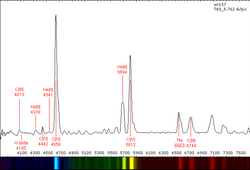Stars/Wolf-Rayets

"Wolf-Rayet stars offer us this most valuable possibility of observing the products of nuclear reactions in the H and He-burning phases revealed at stellar surfaces as a result of mass loss (and maybe of some mixing processes). In particular WC stars are the only kind of stars in which the products of the 3α and associated reactions prominently manifest themselves at the stellar surfaces."[1]
"Wolf-Rayet" (WR) comes from the co-discoverers: Charles Wolf and Georges Rayet. WR 124 is imaged on the rght.
Notations
[edit | edit source]
Notation: let the symbol WC before the word star represent a Wolf-Rayet star exhibiting strong, broad emission lines of helium, carbon, and oxygen.
Notation: let the symbol WN before the word star represent a Wolf-Rayet star exhibiting strong, broad emission lines of helium and nitrogen.
Notation: let the symbol WNE before the word star represent an "early" WN-class Wolf–Rayet star (about WN2 to WN6).
Notation: let the symbol WNL before the word star represent a "late" WN-class Wolf–Rayet star (about WN6 to WN9).
Theoretical Wolf-Rayet stars
[edit | edit source]
"Comparisons are made between the theoretical C/He, N/He, and C/N ratios and those observed by Smith and Willis (1982) and by Nugis (1982) for WNL, WNE, and WC stars. The general agreement strongly supports the advanced evolutionary stage of WR stars as left-over cores resulting from the peeling of massive stars by stellar winds."[1]
See also
[edit | edit source]References
[edit | edit source]- ↑ 1.0 1.1 A. Maeder (April 1983). "Evolution of chemical abundances in massive stars. I - OB stars, Hubble-Sandage variables and Wolf-Rayet stars - Changes at stellar surfaces and galactic enrichment by stellar winds. II - Abundance anomalies in Wolf-Rayet stars in relation with cosmic rays and 22/Ne in meteorites". Astronomy and Astrophysics 120 (1): 113-35. http://adsabs.harvard.edu/full/1983A%26A...120..113M. Retrieved 2013-09-19.
